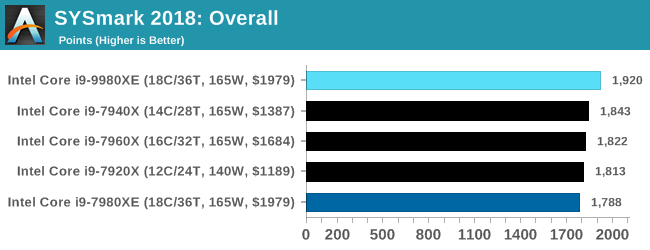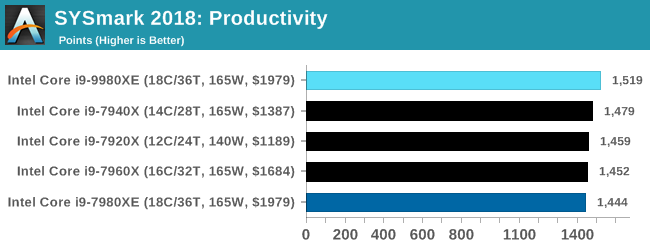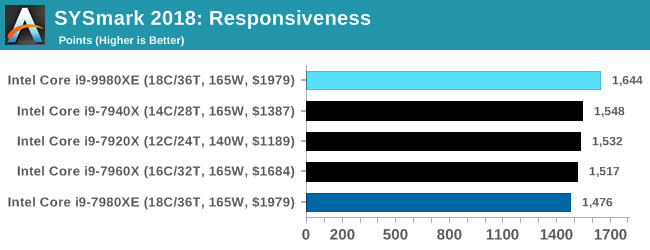The Intel Core i9-9980XE CPU Review: Refresh Until it Hertz
by Ian Cutress on November 13, 2018 9:00 AM ESTHEDT Performance: SYSMark 2018
You either love it or hate it. BAPCo’s SYSMark suite of tests is both an interesting combination of benchmarks but also clouded in a substantial amount of ire. The altruistic original goal was to develop an industry standard suite of real-world tests. AMD (and NVIDIA) left BAPCo several years ago citing that workloads were being chosen on purpose that favoured Intel processors, and didn’t include enough several emerging computing paradigms for the industry. Intel disagrees with that statement, and here we are today.
We run this disclaimer on our SYSMark testing primarily to emphasise that this benchmark suite, while some consider it more than relevant and encompassing a lot of modern professional software, others feel is engineered with specific goals in mind.
We haven’t run SYSMark on every processor, as it requires a fresh OS image compared to our automated suite, and requires refreshing that image every seven days. As a result we are trying to do sets of processors at a time where it makes sense and when time is available.

It’s clear from the Intel comparisons that the i9-9980XE takes a lead here, with a nice bump over the 7980XE of around 7% in the overall test. Given that the 7900X is the best of the Skylake-X processors, it will be interesting to see what the 9900X scores here.













143 Comments
View All Comments
Cellar Door - Tuesday, November 13, 2018 - link
The best part is that an i7 part(9800X) is more expensive then a i9 part(9900k). Intel smoking some good stuff.DigitalFreak - Tuesday, November 13, 2018 - link
You're paying more for those extra 28 PCI-E lanesHixbot - Tuesday, November 13, 2018 - link
And much more L3. It's also interesting that HEDT is no longer behind in process node.Hixbot - Tuesday, November 13, 2018 - link
And AVX512eastcoast_pete - Tuesday, November 13, 2018 - link
@Ian: Thanks, good overview and review!Agree on the "iteration when an evolutionary upgrade was needed"; it seems that Intel's development was a lot more affected by its blocked/constipated transition to 10 nm (now scrapped), and the company's attention was also diverted by its forays into mobile (didn't work out so great) and looking for progress elsewhere (Altera acquisition). This current "upgrade" is mainly good for extra PCI-e lanes (nice to have more), but it's performance is no better than the previous generation. If the new generation chips from AMD are halfway as good as they promise, Intel will loose a lot more profitable ground in the server and HEDT space to AMD.
@Ian, and all: While Intel goes on about their improved FinFet 14 nm being the reason for better performance/Wh, I wonder how big the influence of better heat removal through the (finally again) soldered heat spreader is? Yes, most of us like to improve cooling to be able to overclock more aggressively, but shouldn't better cooling also improve the overall efficiency of the processor? After all, semiconductors conduct more current as they get hotter, leading to ever more heat and eventual "gate crashing". Have you or anybody else looked at performance/Wh between, for example, an i7 8700 with stock cooler and pasty glued heat spreader vs. the same processor with proper delidding, liquid metal replacement and a great aftermarket cooler, both at stock frequencies? I'd expect the better cooled setup to have more performance/Wh, but is that the case?
Arbie - Tuesday, November 13, 2018 - link
The "Competition" chart is already ghastly for Intel. Imagine how much worse it will be when AMD moves to 7 nm with Zen 2.zepi - Tuesday, November 13, 2018 - link
How about including some kind of DB test?I think quite a few people are looking at these workstation class CPU's to develop BI things and it might quite helpful to actually measure results with some SQL / NoSQL / BI-suites. Assuming bit more complex parallel SQL executions with locking could show some interesting differences between NUMA-Threadrippers and Intels.
GreenReaper - Wednesday, November 14, 2018 - link
It's a good idea, Phoronix does them so in the short term you could probably look there.jospoortvliet - Friday, November 16, 2018 - link
But then make sure it is realistic, not running in cache or such... A real db suitable for these chips is terabytes, merely keeping the index in ram... rule of thumb: if your index fits in cache your database doesn't need this CPU ;-)FunBunny2 - Tuesday, November 13, 2018 - link
I guess I can run my weather simulation in Excel on my personal machine now. neato.